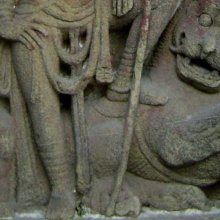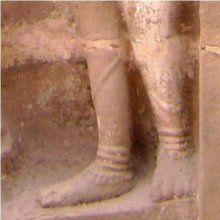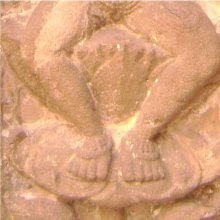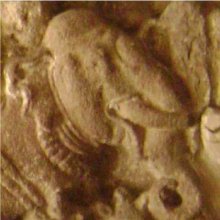Kinkini, Kiṅkini, Kiṅkiṇī, Kiṅkinī, Kiṃkiṇī, Kimkini, Kiṇkiṇi: 26 definitions
Introduction:
Kinkini means something in Buddhism, Pali, Hinduism, Sanskrit, the history of ancient India, Marathi, Jainism, Prakrit, biology, Tamil. If you want to know the exact meaning, history, etymology or English translation of this term then check out the descriptions on this page. Add your comment or reference to a book if you want to contribute to this summary article.
Images (photo gallery)
(+2 more images available)
In Hinduism
Natyashastra (theatrics and dramaturgy)
Source: Wisdom Library: Nāṭya-śāstraKiṅkiṇī (किङ्किणी) refers to a type of ornament (ābharaṇa) for the ankles (gulpha) to be worn by females, according to Nāṭyaśāstra chapter 23. Such ornaments for females should be used in cases of human females and celestial beings (gods and goddesses).
Ābharaṇa (‘ornaments’, eg., kiṅkiṇī) is a category of alaṃkāra, or “decorations”, which in turn is a category of nepathya, or “costumes and make-up”, the perfection of which forms the main concern of the Āhāryābhinaya, or “extraneous representation”, a critical component for a successful dramatic play.
Source: archive.org: The mirror of gesture (abhinaya-darpana)The Bells (kinkinī).—The Bells should be made of bronze or copper or silver; they should be sweet-toned, well-shaped, dainty, with the asterisms for their presiding deities, tied with an indigo string, with a knot between each pair of bells. At the time of dancing there should be a hundred or two hundred for each foot, or a hundred for the right foot and two hundred for the left.

Natyashastra (नाट्यशास्त्र, nāṭyaśāstra) refers to both the ancient Indian tradition (shastra) of performing arts, (natya—theatrics, drama, dance, music), as well as the name of a Sanskrit work dealing with these subjects. It also teaches the rules for composing Dramatic plays (nataka), construction and performance of Theater, and Poetic works (kavya).
Purana and Itihasa (epic history)
Source: Google Books: Cultural History from the Vāyu PurānaKiṅkiṇī (किङ्किणी)—One of the Heavenly ornaments according to the Vāyu Purāṇa. Its use is associated with Skanda (?) and also with Śiva.
Source: archive.org: Shiva Purana - English TranslationKiṅkiṇī (किङ्किणी) or Kiṅkiṇījāla refers to “tinkling ornaments”, according to the Śivapurāṇa 2.3.4.—Accordingly, as the Gods eulogized Umā (Durgā/Satī) with devotion:—“[...] thus eulogised by the Gods, the Goddess Durgā, the mother of the universe, the destroyer of impassable distress, appeared in front of them. She was seated in a wonderful divine gem-set chariot over which a soft cushion had been spread and which was decorated with tinkling ornaments (i.e., kiṅkiṇī-jāla-saṃyukta)”.

The Purana (पुराण, purāṇas) refers to Sanskrit literature preserving ancient India’s vast cultural history, including historical legends, religious ceremonies, various arts and sciences. The eighteen mahapuranas total over 400,000 shlokas (metrical couplets) and date to at least several centuries BCE.
Shaivism (Shaiva philosophy)
Source: Shodhganga: Mantra-sādhana: Chapter One of the KakṣapuṭatantraKiṅkiṇī (किङ्किणी) is the name of an Āgama or Tantra mentioned in the Kakṣapuṭatantra verse 1.5-7.—“At a previous time, when Pārvatī asked him, Śaṅkara told of the attainments of vidyā in the wide worldly life, in various ways. I observed each teaching taught also by the troops of Gods, Siddhas (those who have attained supernatural power), Munis (saints), Deśikas (spiritual teachers), and Sādhakas (tantric practicioners). They are [, for example]: Kiṅkiṇī... I shall carefully extract all the above-mentioned āgamas, which are transmitted from mouth to mouth, like butter extracted from coagulated milk”.
Source: academia.edu: The Yoga of the MālinīvijayottaratantraKiṅkiṇī (किङ्किणी) refers to one of the ten kinds of sounds (śabda) according to the Matsyendrasaṃhitā.
Source: SOAS University of London: Protective Rites in the Netra TantraKiṅkiṇī (किङ्किणी) refers to a “small bell”, according to the Netratantra of Kṣemarāja: a Śaiva text from the 9th century in which Śiva (Bhairava) teaches Pārvatī topics such as metaphysics, cosmology, and soteriology.—Accordingly, [verse 13.1-9, while describing the appearance and worship of Viṣṇu, in the form of Nārāyaṇa]—“He should always think of the four-armed Nārāyaṇa arising. [...] Deva bears divine garments [and] sits atop a divine flower [i.e., a lotus]. [He is] decorated with a gleaming crown of rubies, a small bell (kiṅkiṇī—...kiṅkiṇījālamaṇḍitam), and a net [and] wears heavenly earrings. [...]”.

Shaiva (शैव, śaiva) or Shaivism (śaivism) represents a tradition of Hinduism worshiping Shiva as the supreme being. Closely related to Shaktism, Shaiva literature includes a range of scriptures, including Tantras, while the root of this tradition may be traced back to the ancient Vedas.
Shaktism (Shakta philosophy)
Source: Google Books: Manthanabhairavatantram1) Kiṃkiṇī (किंकिणी) is the name of the Gesture (mudrā) associated with the sacred seat of Pūrṇagiri (pūrṇapīṭha), according to the Manthānabhairavatantra, a vast sprawling work that belongs to a corpus of Tantric texts concerned with the worship of the goddess Kubjikā.—Accordingly:—“Pūrṇapīṭha is called Sound. Endowed with all the energies, it is yellow and on the path on the left. [...] The cremation ground, which brings fear to the fettered, is Ekakoṇa. The gesture there is Kiṃkiṇī. (It possesses) divine authority in the Kaula (tradition), endowed with the most excellent Vaṭuka, (while) the guardian of the field is Pauṇḍara. It is well known (as being) in the left part (of the Triangle) and, divided into sixteen divisions, bow (your) head (to it)”.
2) Kiṅkiṇī (किङ्किणी) refers to “tinkling (anklets)” and is used to visualize Bhairava, according to the Manthānabhairavatantra.—Accordingly, “[...] His body is adorned on the left (by his consort) and he is adorned with a garland of wild flowers. He wears earrings made of snake and his sacred thread is Vāsuki. The Lord is adorned with tinkling anklets [i.e., kiṅkiṇī-dhāra-nūpura] and sits on a ghost in the lotus posture. [...]”.
3) Kiṃkiṇī (किंकिणी) refers to the Gesture associated with Pūrṇagiri, one of the eight Sacred Seats (pīṭha), according to the Yogakhaṇḍa (chapter 14) of the Manthānabhairavatantra.

Shakta (शाक्त, śākta) or Shaktism (śāktism) represents a tradition of Hinduism where the Goddess (Devi) is revered and worshipped. Shakta literature includes a range of scriptures, including various Agamas and Tantras, although its roots may be traced back to the Vedas.
Sports, Arts and Entertainment (wordly enjoyments)
Source: archive.org: Syainika Sastra of Rudradeva with English Translation (art)Kiṅkiṇī (किङ्किणी) refers to “small bells” (attached to the legs of hawks), according to the Śyainika-śāstra: a Sanskrit treatise dealing with the divisions and benefits of Hunting and Hawking, written by Rājā Rudradeva (or Candradeva) in possibly the 13th century.—Accordingly, [while discussing the treatment of hawks]: “Finding the birds healthy and well-developed, [...] when they look like snakes which have just cast off their old sloughs, when with their feet fastened with silken jesses they assume variegated colours from the rays of the jewels in their golden necklaces, their leg rings resound with small bells (kiṅkiṇī-rāva-mukhara), [...] their owner should then call them on auspicious day. [...]”.

This section covers the skills and profiencies of the Kalas (“performing arts”) and Shastras (“sciences”) involving ancient Indian traditions of sports, games, arts, entertainment, love-making and other means of wordly enjoyments. Traditionally these topics were dealt with in Sanskrit treatises explaing the philosophy and the justification of enjoying the pleasures of the senses.
In Buddhism
Tibetan Buddhism (Vajrayana or tantric Buddhism)
Source: academia.edu: The Structure and Meanings of the Heruka MaṇḍalaKiṅkinī (किङ्किनी) is the name of a Ḍākinī who, together with the Vīra (hero) named Kiṅkini forms one of the 36 pairs situated in the Ākāśacakra, according to the 10th century Ḍākārṇava chapter 15. Accordingly, the ākāśacakra refers to one of the three divisions of the dharma-puṭa (‘dharma layer’), situated in the Herukamaṇḍala. The 36 pairs of Ḍākinīs [viz., Kiṅkinī] and Vīras are dark blue in color; they each have one face and four arms; they hold a skull bowl, a skull staff, a small drum, and a knife. Alternatively, the Ḍākinīs have their own marks and motions according to the taste instead of a small drum and a skull staff.

Tibetan Buddhism includes schools such as Nyingma, Kadampa, Kagyu and Gelug. Their primary canon of literature is divided in two broad categories: The Kangyur, which consists of Buddha’s words, and the Tengyur, which includes commentaries from various sources. Esotericism and tantra techniques (vajrayāna) are collected indepently.
India history and geography
Source: Singhi Jain Series: Ratnaprabha-suri’s Kuvalayamala-katha (history)Kiṅkiṇī (किङ्किणी) refers to “bells (attached to banners)”, which commonly decorated the Vimānas (temple complex) of ancient India, as vividly depicted in the Kathās (narrative poems) such as Uddyotanasūri in his 8th-century Kuvalayamālā (a Prakrit Campū, similar to Kāvya poetry).—Page 92.24-31: A Devī-vimāna is described as being decorated with rubies, pearls-pendants and festoons, rows of bells (kiṅkiṇī-mālā) attached to banners, rows of vaijayantī flags fixed on the top, lotus-medallions formed by the inset work of rubies, figures of the lotus-pond and thus giving appearance of Padma-vimāna. [...]

The history of India traces the identification of countries, villages, towns and other regions of India, as well as mythology, zoology, royal dynasties, rulers, tribes, local festivities and traditions and regional languages. Ancient India enjoyed religious freedom and encourages the path of Dharma, a concept common to Buddhism, Hinduism, and Jainism.
Biology (plants and animals)
Source: Google Books: CRC World Dictionary (Regional names)Kinkini in India is the name of a plant defined with Crotalaria laburnifolia in various botanical sources. This page contains potential references in Ayurveda, modern medicine, and other folk traditions or local practices It has the synonym Clavulium laburnifolium (L.) M.R. Almeida (among others).
Example references for further research on medicinal uses or toxicity (see latin names for full list):
· Journal de Botanique, Appliquée à l’Agriculture, à la Pharmacie, à la Médecine et aux Arts (1814)
· Cytologia (1979)
· Flora of Maharashtra State (1998)
· Prodromus Systematis Naturalis Regni Vegetabilis (1825)
· Annales des Sciences Naturelles (Paris) (1825)
· Botanische Jahrbücher für Systematik, Pflanzengeschichte und Pflanzengeographie (1913)
If you are looking for specific details regarding Kinkini, for example diet and recipes, chemical composition, side effects, pregnancy safety, health benefits, extract dosage, have a look at these references.

This sections includes definitions from the five kingdoms of living things: Animals, Plants, Fungi, Protists and Monera. It will include both the official binomial nomenclature (scientific names usually in Latin) as well as regional spellings and variants.
Languages of India and abroad
Pali-English dictionary
Source: BuddhaSasana: Concise Pali-English Dictionarykiṅkiṇī : (f.) a jingling bell.

Pali is the language of the Tipiṭaka, which is the sacred canon of Theravāda Buddhism and contains much of the Buddha’s speech. Closeley related to Sanskrit, both languages are used interchangeably between religions.
Marathi-English dictionary
Source: DDSA: The Molesworth Marathi and English Dictionarykiṅkiṇī (किंकिणी).—f S A girdle of small bells: also a single bell of any tinkling ornament. Ex. dhanuṣyāsa caḍhavuni guṇa || kānāḍi ōḍhūna ākarṇa || jhaṇatkārati kiṃ0 ॥.
Marathi is an Indo-European language having over 70 million native speakers people in (predominantly) Maharashtra India. Marathi, like many other Indo-Aryan languages, evolved from early forms of Prakrit, which itself is a subset of Sanskrit, one of the most ancient languages of the world.
Sanskrit dictionary
Source: DDSA: The practical Sanskrit-English dictionaryKiṅkiṇī (किङ्किणी).—
1) A small bell or tinkling ornament; क्वणत्कनककिङ्किणीझणझणा- यितस्यन्दनैः (kvaṇatkanakakiṅkiṇījhaṇajhaṇā- yitasyandanaiḥ) Uttararāmacarita 5.5;6.1; Śiśupālavadha 9.74; Kumārasambhava 7.49.
2) Name of an acid sort of grape.
See also (synonyms): kiṅkaṇī, kiṅkiṇikā, kiṅkaṇīkā.
Source: Cologne Digital Sanskrit Dictionaries: Shabda-Sagara Sanskrit-English DictionaryKiṅkiṇi (किङ्किणि).—f. (-ṇiḥ or -ṇī) 1. A girdle of small bells, or any tinkling ornament. 2. An acid sort of grape. E. kiṃ some, and kiṇa an imitative sound, affix ka, with in or ṅīṣ fem. affix; also with kan added kiṅkiṇīkā.
Source: Cologne Digital Sanskrit Dictionaries: Benfey Sanskrit-English DictionaryKiṅkiṇī (किङ्किणी).— (onomatop.) f., and kiṅkiṇīka kiṅkiṇī + ka, m. and n. A small bell, [Rāmāyaṇa] 3, 28, 32.
Source: Cologne Digital Sanskrit Dictionaries: Cappeller Sanskrit-English DictionaryKiṅkiṇī (किङ्किणी).—[feminine] a small bell.
Source: Cologne Digital Sanskrit Dictionaries: Monier-Williams Sanskrit-English Dictionary1) Kiṅkiṇī (किङ्किणी):—[from kiṅkiṇa] a f. a small bell, [Mahābhārata; Harivaṃśa] etc.
2) [v.s. ...] Name of an acid sort of grape (= Vikaṅkata), [cf. Lexicographers, esp. such as amarasiṃha, halāyudha, hemacandra, etc.]
3) [v.s. ...] Name of a goddess, [Tantrasāra]
4) Kiṅkiṇi (किङ्किणि):—[from kiṅkiṇa] f. (= ṇī) a small bell, [cf. Lexicographers, esp. such as amarasiṃha, halāyudha, hemacandra, etc.]
5) Kiṅkiṇī (किङ्किणी):—[from kiṅkiṇa] b (f. of kiṅkiṇa q.v.)
Source: Cologne Digital Sanskrit Dictionaries: Yates Sanskrit-English DictionaryKiṅkiṇi (किङ्किणि):—[kiṅki+ṇi] (ṇiḥ) 2. f. A girdle of small bells; an acid sort of grape.
Source: DDSA: Paia-sadda-mahannavo; a comprehensive Prakrit Hindi dictionary (S)Kiṅkiṇī (किङ्किणी) in the Sanskrit language is related to the Prakrit words: Kiṃkiṇī, Khiṃkhiṇī.
[Sanskrit to German]
Sanskrit, also spelled संस्कृतम् (saṃskṛtam), is an ancient language of India commonly seen as the grandmother of the Indo-European language family (even English!). Closely allied with Prakrit and Pali, Sanskrit is more exhaustive in both grammar and terms and has the most extensive collection of literature in the world, greatly surpassing its sister-languages Greek and Latin.
Prakrit-English dictionary
Source: DDSA: Paia-sadda-mahannavo; a comprehensive Prakrit Hindi dictionaryKiṃkiṇī (किंकिणी) in the Prakrit language is related to the Sanskrit word: Kiṅkiṇī.
Prakrit is an ancient language closely associated with both Pali and Sanskrit. Jain literature is often composed in this language or sub-dialects, such as the Agamas and their commentaries which are written in Ardhamagadhi and Maharashtri Prakrit. The earliest extant texts can be dated to as early as the 4th century BCE although core portions might be older.
Kannada-English dictionary
Source: Alar: Kannada-English corpusKiṃkiṇi (ಕಿಂಕಿಣಿ):—
1) [noun] a set of chiming bells attached to an ornament, as anklet, girdle, etc.
2) [noun] the sound produced by chiming bells.
--- OR ---
Kiṃkini (ಕಿಂಕಿನಿ):—[noun] intense anger; wrath.
Kannada is a Dravidian language (as opposed to the Indo-European language family) mainly spoken in the southwestern region of India.
Tamil dictionary
Source: DDSA: University of Madras: Tamil LexiconKiṅkiṇi (கிங்கிணி) noun < kiṅkiṇī. cf. கிண்கிணி. [kinkini.]
1. Tinkling ornament for the ankle; பாத சதங்கை. (பிங்கலகண்டு) [patha sathangai. (pingalagandu)]
2. Girdle of small bells; அரைச் சதங்கை. மாணிக்கக் கிங்கிணி தன்னரை யாட [arais sathangai. manikkag kingini thannarai yada] (நாலாயிர திவ்யப்பிரபந்தம் பெரிய.ாழ். [nalayira thivyappirapandam periyazh.] 1, 8, 2).
3. A species of rattlewort, medium shrub, Crotalaria pulcherrima; கிலுகிலுப்பை வகை. [kilugiluppai vagai.]
--- OR ---
Kiṇkiṇi (கிண்கிணி) noun < கிண்கிண் [kinkin] onom. See கிங்கிணி. தவளை வாய பொலஞ்செய் கிண்கிணி [kingini. thavalai vaya polanchey kinkini] (குறுந்தொகை [kurundogai] 148).
Tamil is an ancient language of India from the Dravidian family spoken by roughly 250 million people mainly in southern India and Sri Lanka.
See also (Relevant definitions)
Starts with: Kimkinia, Kimkinidama, Kimkinikvanita, Kimkinirava, Kimkiniruti, Kimkinivogu, Kin-kini-vaycey, Kin-kini-vaykol, Kinkini-malainel, Kinkinijala, Kinkinijalamalin, Kinkinika, Kinkinikajala, Kinkinikapupphiya, Kinkinikashrama, Kinkinikin, Kinkinimala, Kinkinimalai, Kinkinimandita, Kinkinisayaka.
Full-text (+24): Kinkani, Kinkinika, Kimkini, Kinkinisayaka, Kinkini-malainel, Kinkiri, Kinkinijalamalin, Kinkirin, Kimkiniya, Khimkhini, Kinkinimalai, Ti Kinkinipupphiya, Kankani, Kin-kini-vaykol, Paratu, Kalin-kalinenal, Kanka, Kankana, Akashacakra, Kinakinayati.
Relevant text
Search found 26 books and stories containing Kinkini, Kiṅkini, Kiṅkiṇī, Kiṅkinī, Kiṅkiṇi, Kiṃkini, Kiṃkiṇi, Kiṅkini, Kiṃkiṇī, Kimkini, Kiṇkiṇi, Kingini; (plurals include: Kinkinis, Kiṅkinis, Kiṅkiṇīs, Kiṅkinīs, Kiṅkiṇis, Kiṃkinis, Kiṃkiṇis, Kiṃkiṇīs, Kimkinis, Kiṇkiṇis, Kinginis). You can also click to the full overview containing English textual excerpts. Below are direct links for the most relevant articles:
Pallava period (Social and Cultural History) (by S. Krishnamurthy)
Leg Ornaments < [Chapter 4 - Material Culture of the People]
Conclusion (Material Culture) < [Chapter 5 - Conclusion]
Ornaments For Animals < [Chapter 4 - Material Culture of the People]
Bhakti-rasamrta-sindhu (by Śrīla Rūpa Gosvāmī)
Verse 3.3.37 < [Part 3 - Fraternal Devotion (sakhya-rasa)]
Verse 3.4.28 < [Part 4 - Parenthood (vātsalya-rasa)]
The Devi Bhagavata Purana (by Swami Vijñanananda)
Garga Samhita (English) (by Danavir Goswami)
Verse 1.19.4 < [Chapter 19 - Breaking of the Two Arjuna Trees]
Verse 2.4.16 < [Chapter 4 - The Liberation of Vatsāsura]
Verse 1.2.44 < [Chapter 2 - Description of the Abode of Śrī Goloka]
Chaitanya Bhagavata (by Bhumipati Dāsa)
Verse 1.4.65 < [Chapter 4 - Name-giving Ceremony, Childhood Pastimes, and Thieves Kidnap the Lord]
Verse 1.12.160 < [Chapter 12 - The Lord’s Wandering Throughout Navadvīpa]





